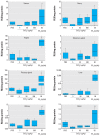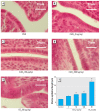Estrogen-like effects of cadmium in vivo do not appear to be mediated via the classical estrogen receptor transcriptional pathway
- PMID: 20525538
- PMCID: PMC2957917
- DOI: 10.1289/ehp.1001967
Estrogen-like effects of cadmium in vivo do not appear to be mediated via the classical estrogen receptor transcriptional pathway
Abstract
Background: Cadmium (Cd), a ubiquitous food contaminant, has been proposed to be an endocrine disruptor by inducing estrogenic responses in vivo. Several in vitro studies suggested that these effects are mediated via estrogen receptors (ERs).
Objective: We performed this study to clarify whether Cd-induced effects in vivo are mediated via classical ER signaling through estrogen responsive element (ERE)-regulated genes or if other signaling pathways are involved.
Methods: We investigated the estrogenic effects of cadmium chloride (CdCl2) exposure in vivo by applying the Organisation for Economic Co-operation and Development (OECD) rodent uterotrophic bioassay to transgenic ERE-luciferase reporter mice. Immature female mice were injected subcutaneously with CdCl2 (5, 50, or 500 µg/kg body weight) or with 17α-ethinylestradiol (EE2) on 3 consecutive days. We examined uterine weight and histology, vaginal opening, body and organ weights, Cd tissue retention, activation of mitogen-activated protein kinase (MAPK) pathways, and ERE-dependent luciferase expression.
Results: CdCl2 increased the height of the uterine luminal epithelium in a dose-dependent manner without increasing the uterine wet weight, altering the timing of vaginal opening, or affecting the luciferase activity in reproductive or nonreproductive organs. However, we observed changes in the phosphorylation of mouse double minute 2 oncoprotein (Mdm2) and extracellular signal-regulated kinase (Erk1/2) in the liver after CdCl2 exposure. As we expected, EE2 advanced vaginal opening and increased uterine epithelial height, uterine wet weight, and luciferase activity in various tissues.
Conclusion: Our data suggest that Cd exposure induces a limited spectrum of estrogenic responses in vivo and that, in certain targets, effects of Cd might not be mediated via classical ER signaling through ERE-regulated genes.
Figures





Similar articles
-
Arsenite and Cadmium Activate MAPK/ERK via Membrane Estrogen Receptors and G-Protein Coupled Estrogen Receptor Signaling in Human Lung Adenocarcinoma Cells.Toxicol Sci. 2016 Jul;152(1):62-71. doi: 10.1093/toxsci/kfw064. Epub 2016 Apr 12. Toxicol Sci. 2016. PMID: 27071941
-
Cadmium-induced effects on cellular signaling pathways in the liver of transgenic estrogen reporter mice.Toxicol Sci. 2012 May;127(1):66-75. doi: 10.1093/toxsci/kfs077. Epub 2012 Feb 7. Toxicol Sci. 2012. PMID: 22314386
-
From pure compounds to complex exposure: Effects of dietary cadmium and lignans on estrogen, epidermal growth factor receptor, and mitogen activated protein kinase signaling in vivo.Toxicol Lett. 2016 Jun 24;253:27-35. doi: 10.1016/j.toxlet.2016.04.020. Epub 2016 Apr 22. Toxicol Lett. 2016. PMID: 27108949
-
New aspects of cadmium as endocrine disruptor.Environ Sci. 2006;13(2):107-16. Environ Sci. 2006. PMID: 16788562 Review.
-
Critical review and evaluation of the uterotrophic bioassay for the identification of possible estrogen agonists and antagonists: in support of the validation of the OECD uterotrophic protocols for the laboratory rodent. Organisation for Economic Co-operation and Development.Crit Rev Toxicol. 2002;32(6):445-520. doi: 10.1080/20024091064291. Crit Rev Toxicol. 2002. PMID: 12487363 Review.
Cited by
-
Transcriptome assembly and expression profiling of the molecular responses to cadmium toxicity in cerebral ganglia of wolf spider Pardosa pseudoannulata (Araneae: Lycosidae).Ecotoxicology. 2018 Mar;27(2):198-208. doi: 10.1007/s10646-017-1885-1. Epub 2018 Jan 3. Ecotoxicology. 2018. PMID: 29299797 Free PMC article.
-
Using expression profiling to understand the effects of chronic cadmium exposure on MCF-7 breast cancer cells.PLoS One. 2013 Dec 20;8(12):e84646. doi: 10.1371/journal.pone.0084646. eCollection 2013. PLoS One. 2013. PMID: 24376830 Free PMC article.
-
Persisting neurobehavioral consequences of gestational exposure to cadmium and benzo[a]pyrene in rats.Neurotoxicol Teratol. 2025 Aug 11;111:107546. doi: 10.1016/j.ntt.2025.107546. Online ahead of print. Neurotoxicol Teratol. 2025. PMID: 40803637
-
Cadmium and proliferation in human uterine leiomyoma cells: evidence of a role for EGFR/MAPK pathways but not classical estrogen receptor pathways.Environ Health Perspect. 2015 Apr;123(4):331-6. doi: 10.1289/ehp.1408234. Epub 2014 Oct 24. Environ Health Perspect. 2015. PMID: 25343777 Free PMC article.
-
Cadmium and Reproductive Health in Women: A Systematic Review of the Epidemiologic Evidence.Curr Environ Health Rep. 2014 Jun;1(2):172-184. doi: 10.1007/s40572-014-0013-0. Epub 2014 Mar 21. Curr Environ Health Rep. 2014. PMID: 27453808 Free PMC article.
References
-
- Acconcia F, Kumar R. Signaling regulation of genomic and nongenomic functions of estrogen receptors. Cancer Lett. 2006;238:1–14. - PubMed
-
- Alonso-Gonzalez C, Gonzalez A, Mazarrasa O, Guezmes A, Sánchez-Mateos S, Martínez-Campa C, et al. Melatonin prevents the estrogenic effects of sub-chronic administration of cadmium on mice mammary glands and uterus. J Pineal Res. 2007;42:403–410. - PubMed
-
- Åkesson A, Julin B, Wolk A. Long-term dietary cadmium intake and postmenopausal endometrial cancer incidence: a population-based prospective cohort study. Cancer Res. 2008;68(15):6435–6441. - PubMed
Publication types
MeSH terms
Substances
LinkOut - more resources
Full Text Sources
Research Materials
Miscellaneous

